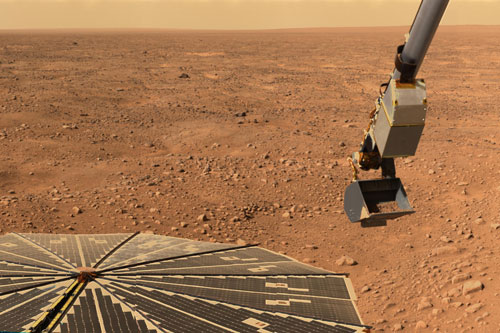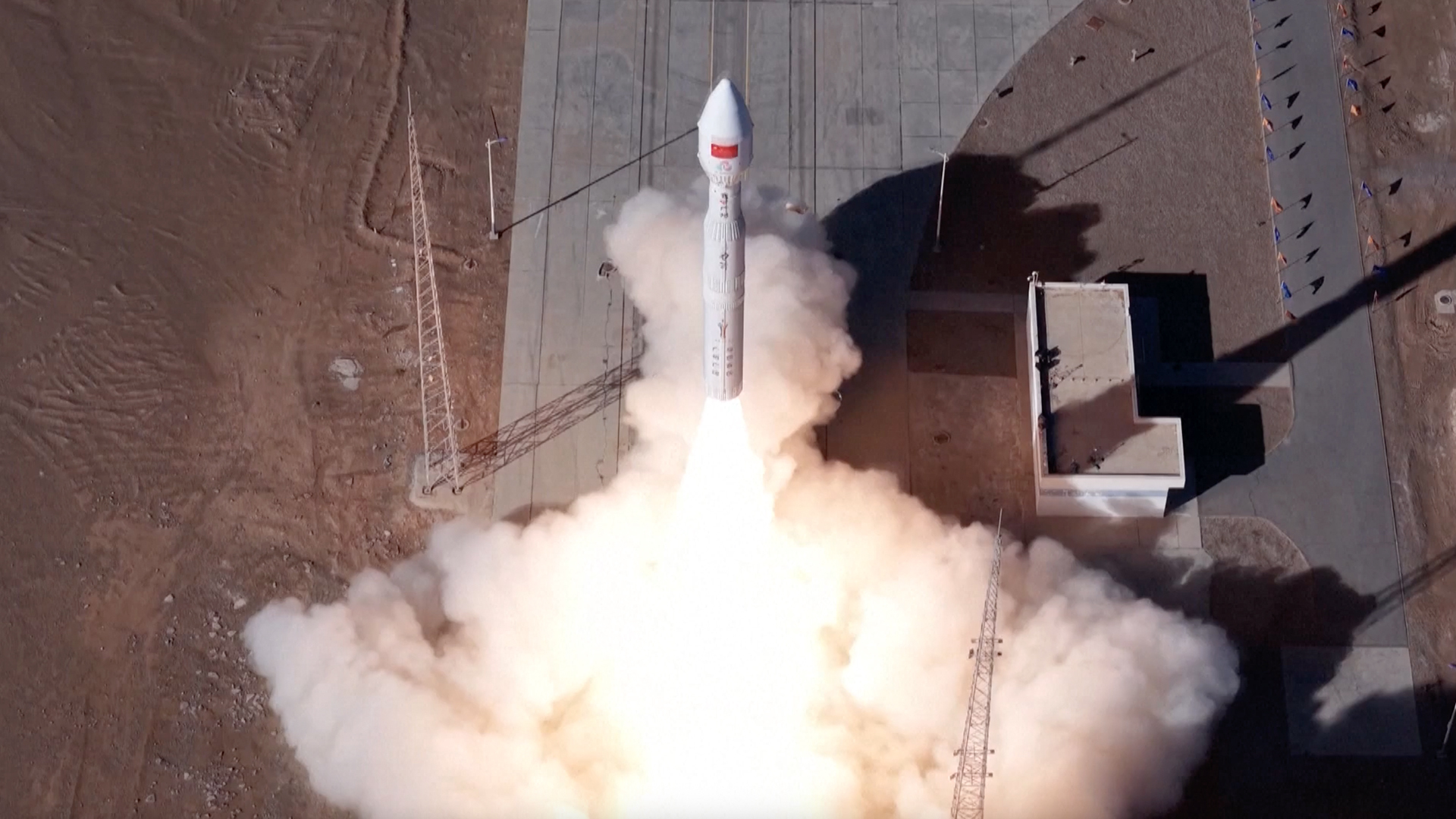Mars Sprinkled with Salty Mysteries

During itsstint in the Martian Arctic, NASA's Phoenix Mars lander made an impressivearray of measurements and discoveries that will help fine-tune scientists'understanding of the chemistry and environment of the red planet.
Perhaps nodiscovery was more surprising than thedetection of an odd type of salt that Phoenixscientists think could have an important impact on the Martian water cycle andthe planet's ability to support life.
In a set ofpapers presented last week at the 40th Lunar and Planetary Science Conference(LPSC) in The Woodlands, Texas, several Phoenix team members put forth theirideas on how the class of salts, called perchlorates, might affect Mars' watercycle; how it might boost or inhibit potential Martian life; how it might forma sludge underneath Mars' polarcap, lubricating them and allowing them to flow, as glaciers do on Earth;and how the salt even got there in the first place.
Anunexpected detection
Phoenix landed in the Vastitas Borealisplains of Mars on May 25, 2008, and spent its five-plus month tenure digging upsamples of Martian dirt and subsurface water ice and analyzing them for signsof the planet's past potential habitability.
The landerunearthed plenty of unanticipated findings: alkaline dirt (where previously itwas thought that Martian regolith was acidic); snowfalling from the sky; and sticky dirt that clumps when scooped up.
But thedetection of perchlorate, made by the lander's Microscopy, Electrochemistry andConductivity Analyzer's (MECA) wet chemistry lab, may have some of the mostinteresting implications for Mars' soil chemistry, water cycle and potentialhabitability.
Breaking space news, the latest updates on rocket launches, skywatching events and more!
The findingwas "totally unexpected," said Phoenix principal investigator PeterSmith of the University of Arizona during a review of the mission after thelander lost power.
Once thedetection was made, several Phoenix scientists began considering whatperchlorate's presence on the red planet could mean for Martian surfacechemistry.
Slipperysludge
MichaelHecht, of NASA's Jet Propulsion Laboratory in Pasadena, Calif. and the leadscientist for the instrument that first detected the perchlorate, and DavidFisher of the Geological Survey of Canada were rooming together in Tucson during the mission and began discussing some of those implications. In particular,they formulated a potential mechanism that could allow the Martianpolar caps to move.
On Earth,heat is constantly escaping from the planet's molten interior, which warms thebottom of glaciers and ice sheets, melting the ice, "and the ice sheetliterally can slide," Hecht explained.
Hecht andFisher suspect that the perchlorate could be allowing the same thing to happenon Mars.
Someobservations of Mars' polar ice caps show characteristics that suggest that theice could be sliding, though not everyone agrees that ice flow is necessary toexplain the features. But at Mars' poles, it's far too cold for ice at the baseof the cap to melt in the same way that it does on Earth.
Perchloratecan get around this problem because it can melt ice even at the frigidtemperatures seen at the bottom of the ice caps.
"It'slike super road salt," Fisher explained.
Phoenix's measurements suggest thatperchlorate makes up about 1 to 2 percent by weight of the surface dirt in Phoenix's landing area. Mars' present polar caps are about 95 percent ice and 5 percentsoil, which means that in 1,000 meters (3,280 feet) of ice, there could beroughly 0.5 meter of perchlorate.
Theperchlorate could either sink down through the ice cap or could be deposited onthe surface as the ice sheets wax and wane every few million years.
"Whereverthere's an ice cap, there's a tendency to build up whatever's in it,"Fisher said.
Thisbuildup of perchlorate would melt enough ice to eventually create a layer ofbrine below the ice cap on which the ice cap could slide.
Fisher hasmodeled the possible ice cap flow and said that it's hard to make the ice movewithout such a sludge. At the LPSC, other scientists agreed that the sludge wasa plausible mechanism for ice flow, though not all agreed that the ice actuallydid flow.
The bestway to find evidence to support the idea would be to detect the sludge aroundthe polar cap. Arvidson and his graduate student have already been using the Mars ReconnaissanceOrbiter's Compact Reconnaissance Imaging Spectrometer for Mars (CRISM)instrument to probe the surface around Phoenix's landing site.
"Wedid a pretty intense search," Arvidson said. But so far CRISM hasn't foundany perchlorate signatures.
"None.Zero. Nada. Zilch," Arvidson said.
But Fisherpoints out that CRISM needs a concentration of at least 5 percent (of thesurface soil) to see the perchlorate; the instrument also needs the compound tobe hydrated. If it is desiccated or present at a lower percentage, theinstrument can't see it.
But even ifthere isn't enough of the perchlorate to create this sludge, the compound couldstill interact with water on the red planet.
"It'sconceivably important in the water cycle," Arvidson said.
MovingMartian water
Perchloratesalts may play a key role in regulating the flow of water between atmosphereand surface on Mars because "these are compounds that suck up water,"Arvidson explained.
This is aparticularly interesting characteristic in the northern plains where Phoenixlanded that are now known to have a layer of water ice just a few inches belowthe surface.
In essence,you have "a significant amount of perchlorate in soil that's sitting ontop of ice," Hecht explained. "It's awfully hard to imagine thatthere aren't mixtures" of perchlorate and water.
Where theconcentrations work out, there would likely be areas where the ice and saltwould form a brine.
But whetherthis would just result in a dampness of the soil or actual brine pools, "Iwouldn't begin to guess," Hecht said.
Phoenix team member Nilton Renno presenteda paper at the LPSC that proposed that a set of "little globules"attached to struts on Phoenix's legs (as photographed by the lander's roboticarm camera) mighthave been liquid water that was splashed up onto the spacecraft as itlanded.
Hechtthinks that while this explanation is not out of the question, it isn't thelikeliest one, which is that water vapor released from exposed patches of icestuck to the lander legs.
It's likelynot the right point in Mars' climate cycle (which changes as the planet'srotation axis wobbles) for liquid brine to form at or near the surface, Hechtexplained. During periods when Mars might have just a few degrees warmer,perchlorate rinds could perhaps have melted water ice.
But Phoenix did observe that the Martian dirt gets damp during the day (which may account forits clumpiness). (The water would be released again into the atmosphere atnight.)
"It'sa lot easier to make soil a little damp than to melt a chunk of ice,"Hecht said.
Though thisdampness isn't necessarily what would be called damp by Earth standards becauseof Mars' inherent dryness.
"Thisis not wet enough to grow a chrysanthemum in, but it's not like you baked it inan oven either," Hecht said.
Impacton life
Perchlorate'spresence in the soil and interaction with water could also have implicationsfor any potentialMartian microbes.
At hightemperatures, perchlorate is "a very aggressive oxidant," Hecht said,but since Mars is so cold, this isn't likely to threaten life there. In fact,"perchlorate is quite benign with respect to microbe," he said. Itcould actually act as an energy source for them (perchlorates provide the boomto most fireworks and rocket propellants).
"A lotof microbes eat perchlorate for lunch," Hecht said. It's "a wonderfulPowerBar for microbes."
But it'salso a powerful desiccant that sucks up any water within its grasp, which wouldput it in competition for this substance that is essential to all life was weknow it.
Bottomline: "There are aspects of perchlorate that are good for life; there areaspects of perchlorate that are bad for life," Hecht added.
Where itcomes from
Figuringout where the perchlorate comes from and how it is deposited on the Martiansurface is another puzzle the Phoenix scientists are trying to piece together.
Thoughperchlorate is found on Earth, it only shows up in the very arid places, suchas the AtacamaDesert wedged between the Pacific Ocean and the Andes and the stratosphere.Though Mars is similarly dry, these Earth analogs only provide so much help inunderstanding the origin of perchlorate on Mars.
"Wedon't completely understand it on Earth either," Hecht said.
Hecht saidthat scientists know that most of the perchlorate originates in the atmosphere,falling from the sky as perchloric acid in precipitation. It then reacts withsilicate minerals on the surface to become perchlorate.
But how thechlorine that reacts to form the perchloric acid gets injected into theatmosphere in the first place isn't known.
In that Atacama Desert, sea spray that blows over the plains can provide the chlorine. Volcanoescan also contribute the element to the air when they erupt. But, of course,there are no seas on Mars right now, which leaves volcanic eruptions andreactions of chloride-containing minerals (either on the surface or aerosols ?tiny particles suspended in the air).
Ozone isnecessary to the reactions that form perchlorate on Earth. Whether or not thisis true of Mars isn't known, but if it is, it could mean that perchlorateswould only be common at the colder, high latitudes of Mars, which see the onlyozone concentrations high enough to fuel the reactions.
Planet-wideperchlorate hunt
Theupcoming Mars Science Laboratory (MSL) mission, set to launch in 2011, couldhelp answer the question of whether the perchlorate is a peculiarity of the Phoenix site or a much more widespread constituent of the Martian regolith.
Intriguingly,the Vikinglanders detected chlorine at their landing sites, which were closer to theMartian equator than Phoenix's site. The landers couldn't determine whatcompound that chlorine came from, but it could have been perchlorate, Arvidsonsaid.
"Nowwe have a specific compound to search out and find" when MSL, which willalso explore more mid-latitude sites, lands on the planet, he said.
- Video ? Looking for Life in All the Right Places
- SPECIAL REPORT: Phoenix Mars Lander: Digging for Ice in the Martian Arctic
- Images: Phoenix on Mars!

Andrea Thompson is an associate editor at Scientific American, where she covers sustainability, energy and the environment. Prior to that, she was a senior writer covering climate science at Climate Central and a reporter and editor at Live Science, where she primarily covered Earth science and the environment. She holds a graduate degree in science health and environmental reporting from New York University, as well as a bachelor of science and and masters of science in atmospheric chemistry from the Georgia Institute of Technology.
